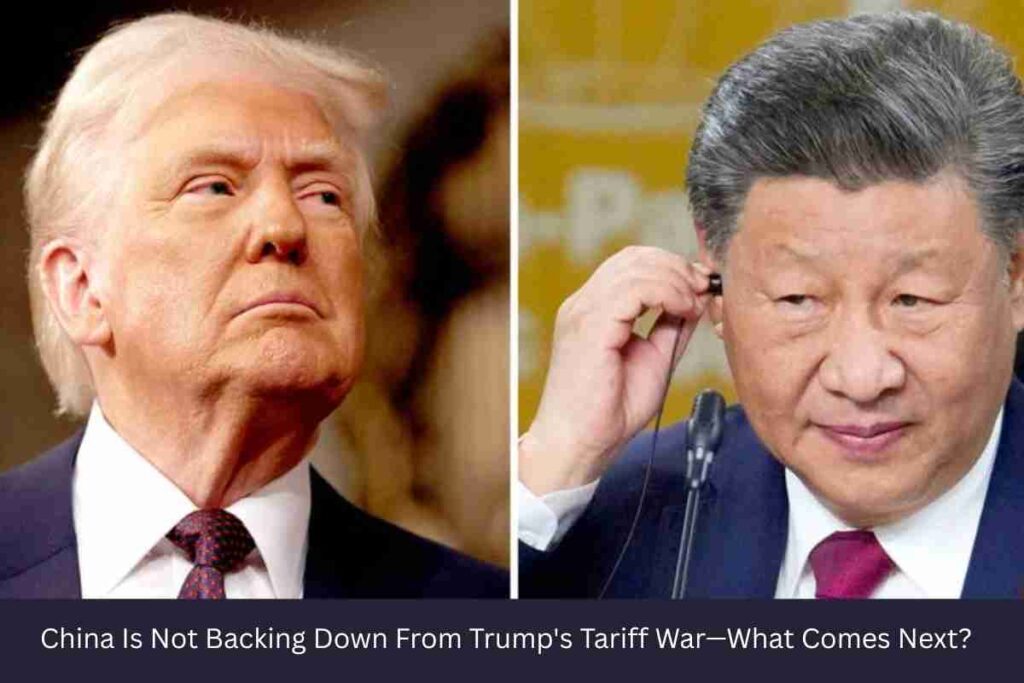China Is Not Backing Down From Trump’s Tariff War—What Comes Next?

China Is Not Backing Down From Trump’s Tariff War—What Comes Next?
The escalating trade war between the United States and China has once again captured the world’s attention. With former President Donald Trump threatening to impose an additional 50% tariff on Chinese goods and Beijing vowing to “fight to the end,” this clash of economic titans leaves economists and global markets bracing for impact.
But why is China refusing to back down, and what ripple effects will this heated standoff produce for the global economy? This blog dives into the implications of the US-China trade war for businesses, governments, and investors, while exploring what might lie ahead.
The Current Situation in the Trade War
The US-China trade war has escalated dramatically in recent weeks. Trump’s announcement of steep tariffs targeting nearly all Chinese imports—including smartphones, machinery, toys, and batteries—has pushed China to retaliate with its own 34% duties on US goods.
Adding fuel to the fire, Trump’s promise of an additional 50% tariff if Beijing does not roll back its recent measures has sent shockwaves through global markets. Asian stocks, for example, have experienced historic drops, with only minor recoveries seen in the aftermath.
On the other hand, China has responded by actively bracing for further economic strain. Beyond tit-for-tat tariffs, Beijing is employing broader strategies, including:
- Depreciating its currency (yuan): This helps mitigate the impact of tariffs by making Chinese exports more attractive.
- State-linked interventions: Chinese enterprises have been buying stocks to stabilize local markets.
These moves underscore China’s readiness to endure short-term pain while signaling to the US that it will not capitulate under pressure.
Why Won’t China Back Down?
China’s refusal to yield is rooted in both economic strategy and national pride. Submitting to Trump’s tariff demands would not only harm its economy but would also be seen as a loss of sovereignty, a stance Beijing has been keen to avoid.
Economic Pressures
China is heavily reliant on exports, which have traditionally been a key driver of its economic growth. The tariffs threaten to undermine this vital revenue source further, especially as the Chinese economy is already grappling with challenges like:
- A slowing GDP growth rate, with a modest 5% target set for 2025.
- A prolonged property market crisis.
- Rising domestic unemployment rates, which have weakened overall consumption.
Despite these headwinds, China’s strategy is clear—preserve long-term economic autonomy at all costs. The leadership views succumbing to US tariffs as a slippery slope that could invite further “unreasonable demands.”
Political and Cultural Factors
National empowerment is a central theme of Chinese policy under President Xi Jinping. Backing down could weaken political stability domestically and send a message to the world that China can be coerced—a scenario Beijing simply cannot afford.
The Consequences for the Global Economy
The persistent tension between the US and China poses risks that extend far beyond these two nations. Economists liken the situation to a game of chicken, where both sides are pushing the limits of economic endurance.
Impact on the US Economy
While Trump’s tariffs aim to reduce the trade deficit with China, they also come at a cost for American businesses and consumers:
- Higher production costs: Tariffs on imports mean US manufacturers must either absorb increased costs or pass them on to consumers.
- Supply chain disruptions: Shifting away from Chinese suppliers is not a quick fix, and finding alternative sources is challenging given the volume of trade involved.
- Retaliation from Beijing: China’s tariffs are aimed at American agricultural exports, potentially damaging a crucial sector of the US economy.
Impact on the Rest of the World
The ripple effects of this trade war extend globally:
- Emerging markets: Chinese goods shut out from the US market are likely to flood alternate markets, such as Southeast Asia, potentially destabilizing local industries.
- Global supply chains: Countries reliant on raw materials or intermediary goods are particularly vulnerable. For example, tariffs on electronics components could impact tech production across multiple regions.
- Investor confidence: The escalating uncertainty has already resulted in significant stock market volatility, which could hurt global investment trends.
What Comes Next?
The trade war has reached an impasse, and its resolution remains unclear. Several potential outcomes are worth considering:
Scenario 1: Private Negotiations
While publicly the rhetoric remains heated, behind-the-scenes negotiations could yield a ceasefire. Analysts maintain that private discussions might allow both sides to save face without major policy concessions.
Scenario 2: Further Escalation
If neither side blinks, tariffs could escalate further—Trump’s latest threats suggest that the US is not shying away from a full-on economic standoff that would see levies soaring to historically unprecedented levels.
Scenario 3: Broader Economic Retaliation
Economists warn that both nations have tools beyond tariffs. For China, this might include placing restrictions on rare earth exports, depreciating their currency further, or limiting the access of American firms to Chinese consumer markets. For the US, measures could include stricter scrutiny of Chinese investments or greater export controls on hi-tech goods.
Scenario 4: A Shift in Global Trade Alliances
With the US and China locked in a conflict, other nations could seize opportunities to form alliances or renegotiate trade deals. This could reshape the global economic landscape, creating new centers of trade and political power.
How Economists Are Interpreting the Standoff
Experts are divided on whether Trump’s strategy of applying maximum pressure will succeed. On one hand, some view the move as a negotiating tactic meant to squeeze concessions from Beijing. On the other hand, many believe the US is overplaying its hand, underestimating China’s capacity—and willingness—to endure pain for the sake of long-term sovereignty.
Mary Lovely, a US-China trade expert at the Peterson Institute for International Economics, summarizes it well, stating, “What we are seeing is a game of who can bear more pain. We’ve stopped talking about any sense of gain.”
What Should Policymakers and Businesses Do?
Policymakers:
- Diversify trade relationships: To reduce dependence on any single country, nations must seek diverse trade alliances.
- Prepare for volatility: Flexible policy measures can help mitigate market disruptions.
- Promote global dialogue: International institutions should mediate between the US and China wherever possible.
Businesses:
- Shift supply chains: Companies heavily reliant on Chinese manufacturing should explore diversification opportunities, such as sourcing from emerging economies.
- Stay agile: Regularly reassess market and geopolitical developments to adapt swiftly.
- Engage policymakers: Advocate for policies that minimize unnecessary disruptions to trade.
Weathering the Trade War
The US-China trade war reflects a new era of global trade uncertainty, where risks are high, and strategies need constant recalibration. While it’s clear that neither side is eager to back down, the costs of prolonged escalation could restructure the global economy for years to come.
For economists and policymakers, this trade war serves as a case study in navigating unprecedented challenges. And for businesses, adaptability is no longer optional—it’s essential to survival.







